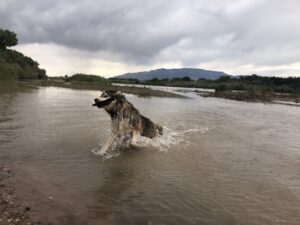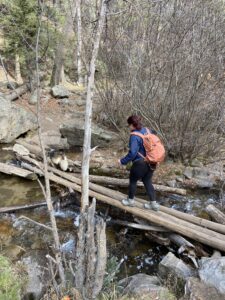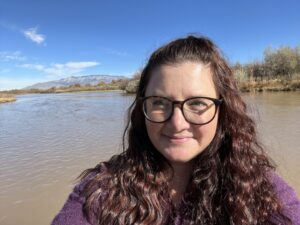
By Tricia Snyder, New Mexico Wild Rivers and Waters Program Director
Nearly every day I take my dog, Mardy, for a stroll in the Bosque—the Spanish word for a riparian forest and commonly used to refer to the vegetation that surrounds the Rio Grande near Albuquerque. The unbridled joy she experiences as we weave our way through the cottonwoods until finally, she can jump into the river, slapping the water with her paw to throw sparkling droplets into the air to catch them in her mouth, is something that never gets old. She reminds me daily of the importance of rivers in our day-to-day life, nourishing our spirits and providing places to play as well as the practical applications they serve, literally bringing life to communities everywhere, both human and non-human.
Today in New Mexico, rivers, streams, and wetlands are threatened like never before. This Saturday marks the one-year anniversary of the U.S. Supreme Court Decision in Sackett v. EPA, the latest in a string

of court decisions and other regulatory changes that has eroded the protections of one of our bedrock environmental laws, the Clean Water Act. Rolling back nearly 50 years of water quality protection, the Sackett decision removed federal jurisdiction for over 90% of surface waters in the state. Combined with previous decisions and regulatory changes, over 96% of New Mexico’s waters are no longer protected under the Clean Water Act.
To highlight this, American Rivers one of our partner conservation organizations, listed every river in New Mexico as the #1 most endangered on their annual list of most endangered rivers in the nation. Although “traditionally navigable” waters like the Rio Grande are still protected, many of the tributaries that feed this iconic river, and so many others across the state, are not. Fundamentally, the Sackett decision removed protections for most ephemeral and intermittent waterways, or those waterways that don’t flow year-round, as well as many wetlands across the state, and established requirements for connection with other protected waterways that disregard best available science and the hydrologic reality of how waters are connected.
If you’ve been following NM Wild in the past year, you probably already know we’re hard at work to rectify this. It has never been more important in the wake of changing federal jurisdiction to ensure we have appropriate protections built in at the state level. Without a state-led surface water quality permitting program, the state can only be reactive and respond to pollution events after they occur, rather than utilizing permitting authority to prevent pollution before it happens.
Thankfully, we’re making important strides in seeing that program become a reality. Governor Lujan Grisham’s administration has long recognized the critical need for this program. In fact, the New Mexico Environment Department (NMED) began efforts to set this program up before the Sackett decision was even finalized. The legislature has voiced its support by appropriating funds over the past few legislative sessions to support this effort, including a monumental $7.6 million in the 2024 session to build a state-led program and to support shared infrastructure with the existing groundwater permitting program.
But the work is just beginning. Over the next couple of years NMED plans to conduct public outreach to better understand how to shape this program to ensure our most precious resource is protected for future generations and for the benefit of communities across the state.
New Mexico Wild, in coalition with a variety of partners, believes this program must be built off a strong foundation of robust public outreach, ensuring those who know these waters best have a say in how they are protected. We also believe the final program must include adequate wetlands protection, including permitting around dredge and fill activities for those wetlands no longer federally protected; a citizen suit component, like what is included in the Clean Water Act and that provides an important mechanism for communities to protest when their waters are being degraded; and meaningful government-to-government collaboration with those Tribes, Pueblos, and Nations that desire it, recognizing the stewardship and cultural ties of these Sovereign Nations to waters and lands they have depended on and cared for since time immemorial.
As we continue to work with NMED, the Governor’s office, and the legislature to ensure this program encompasses all these points and truly sets us on the path to appropriately protecting New Mexico’s rivers, streams, and wetlands, we’ll be calling on our members and supporters to make your voices heard. We’ll need you to speak up about how you connect with these waterways and the important role they play for communities across the state. It’s imperative we get this program up and running as soon as possible—water can’t wait, and our rivers, streams, and wetlands are too important to risk.
Want to do something today? Check out our guide to writing letters to the editor and speak up for rivers! Reach out to Tricia at tricia@nmwild.org for more ways to get involved.


